Last Updated on 29/11/2023 by Dochlaggie. Post first published on March 4, 2022.
Pomeranian patella luxation is a relatively common orthopedic condition in small breed dogs. It occurs when the knee joint becomes unstable and moves out of place, causing pain and lameness. The dog’s kneecap may pop out of its groove or dislocate completely. A vet can fix this with surgery to stabilize the bones.
Luxating patella in small breed dogs such as Pomeranians, Toy and Miniature Poodles, Chihuahuas, Pekingese, Yorkshire Terriers is not an unusual health issue.
With proper treatment, your pet will soon be back to normal. It could happen from just jumping up down from a chair onto hardwood flooring, or as a result of a poor puppy diet, an injury, or genetics.
N.B. This article regarding Pomeranian health issues was written in consultation with our resident veterinarian.
Why is my Pomeranian is Limping?
The usual answer when Pom owners ask why is my Pomeranian is limping on a hind leg is Pomeranian patellar luxation.
In the event, your Pomeranian is limping on the back leg, or in severe cases, the dog won’t put weight on the back leg, veterinary advice should be sought.
What Are Luxating Patellas in Dogs?
The patella is another name for your Pomeranian’s kneecap. A luxating patella happens when your dog’s knee cap slips out of the natural groove where it’s supposed to sit. The big upper leg bone is called the femur, and the groove running down the middle is where the knee cap and ligaments sit.
In the case of patellar luxation, your Pomeranian’s knee cap will slide out of the groove. The main reason is that the bone’s groove isn’t as deep as it should be.
There are instances where the patella slides out of the groove and back in, without external interference. Then there are times when it comes out but refuses to return to its position in the groove.
A luxation may move to the inside of his knee (medially) or the outside of his knee (laterally) and it may happen in one leg or two.
A Pomeranian’s patellar luxation will be graded according to severity or type and uses the grading system designed by the Orthopedic Foundation for Animals (OFA).
Pomeranian Luxating Patella Symptoms
If your dog has a Pomeranian patellar luxation, it’s usually obvious as he’ll generally walk on three legs, holding the affected back leg in the air. Other times he might only favor that leg for a few steps and then walk without any problems. He might put weight on the affected leg while it’s angled strangely.
If your Pomeranian has had a chronic luxating patella and it has created some trauma to his knee over a period of time, it will be obvious. He may limp, demonstrate pain in the knee, and won’t be willing to put even the slightest pressure on the problem leg.
A diagnosis of a luxating patella is commonly reached once an owner observes his dog either favoring one leg when he walks or he limps. What happens is that his knee slips out from the joint connected to his leg.
Has your Pomeranian demonstrated any of these troubles?
What Causes Pomeranian Patellar Luxation?
Environment, as well as genetic influences, play a big part in the health of your Pomeranian. Correct Diet and medication may improve this health issue. Feeding your puppy a balanced diet may help prevent many health problems later in life.
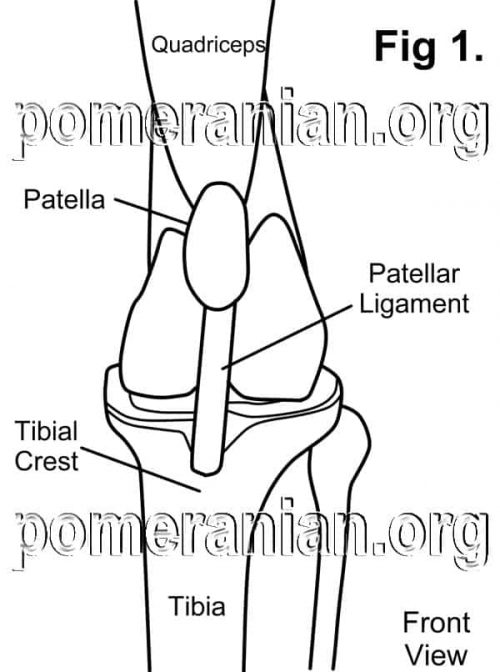
Figure 1 : Above 0 (normal) patella.
The kneecap (patella) is a very small bone found deep in the tendon of the thigh muscles. The tendon is a tough inelastic band of tissue joining the bony attachment and the muscle. With patella luxation, the kneecap can slide out of its tendon and then slide back in again.
Patellar Luxation Grades
Normal = 0. Number 1 signifies minimal movement of the kneecap and the dog’s owner might not be even aware of the problem. As time goes on and this disease may progress in terms of severity and duration, the lameness may occur more often until it’s there all the time.
Pomeranians with severe luxating patellas appear to have “bow-legged” back legs. In grades 2, 3 and 4, surgical intervention usually proves successful.
Patella Luxation – Grades Of Severity

Patella luxation has five distinct grades. Pomeranians should have patella’s evaluated yearly as grading can become progressively worse with age.
- Grade 0 No Luxation: The patella is in it’s normal position and fits snuggly into the knee joint and no movement is felt on examination by a veterinarian.
- Grade 1 Very Little Luxation: The patella is close to being normal. The only way to cause it to become dislocated is for digital pressure to be applied to the knee joint. Kneecap will pop back into place.
- Grade 2 Luxating Patella : When the patella becomes dislocated it will stay that way. Pomeranians that suffer from this problem may have secondary osteoarthritis and joint cartilage problems if the patella is repeatedly being dislocated. Your Pomeranian is limping and may also carry his back leg for a couple of steps before putting it on the ground and walking normally.
- Grade 3 Luxating Patella : Your dog’s patella is dislocated more often than not. If it’s put back in place, it has the tendency to slip out again repeatedly. Pomeranians who have this level of patella luxation also face a higher risk of the anterior cruciate ligament in the stifle rupturing. Dogs falling into this level often suffer some loss of functionality. There are more “skipping” incidents and he’ll try to avoid jumping up as it can cause pain. The patella can’t always return to its normal position.
- Grade 4 Luxating Patella : With grade iv patellar luxation your Pomeranian’s patella is always dislocated. His legs have so much pain that he tries not to use them. He may be unable to straighten the leg and he may have little to no desire to jump or run.
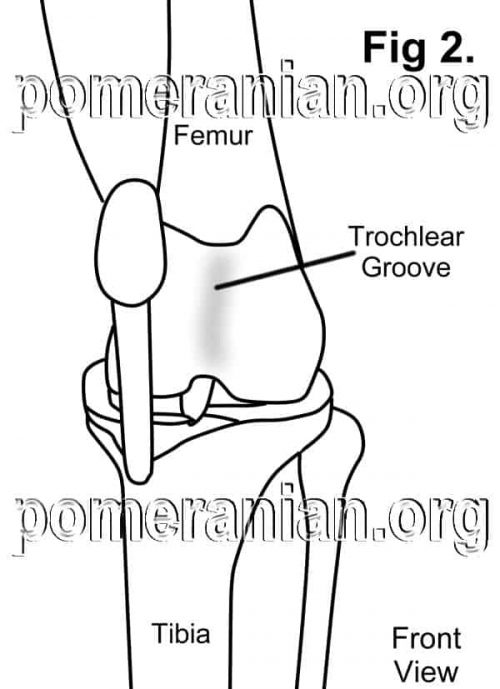
Figure 2: Above 4 (severe) patella luxation. The kneecap is dislocated out of the groove.
Non Surgical Treatment for Luxating Patella in Dogs
Do not consider any type of patella luxation repair surgery until your Pomeranian is at least 12 months. Consider other patellar luxation treatment options first.
Correct Diet and Exercise May Help Prevent Patellar Luxation
- Pomeranian puppies going through the teething stage who are lacking sufficient calcium in their diet might suddenly start limping or even carrying one leg. Other signs of a diet deficient in calcium include down on pastern, east west front, flopping ears and tails doing funny things.
- Your Pomeranian’s diet needs to be reassessed. No red meat at all. Feed puppy tinned food and dry PUPPY food and lots of dairy products until 12 months.
- If your Vet does want to perform patella luxation repair surgery on a Pomeranian under 12 months of age, serious consideration should be given to changing your Vet.
- It’s vital that you feed your Pomeranian a well-balanced, nutritious diet and ensure his weight stays within a healthy range.
- Don’t let your Pomeranian jump up and down from furniture, beds or steps and while mild and regular exercise to build muscle may help Pomeranians with lower patella grades, avoid too much exercise.
- If the problem is severe and your Pomeranian is in pain, surgery may be the only option.
- Pomeranians should be removed from breeding programs if the patellar luxation grades are either 2, 3 or 4.
- Oral joint supplements for dogs may prove beneficial. I personally recommend All-Natural Hip & Joint Supplement for Dogs – With Glucosamine, Chondroitin, MSM, and Organic Turmeric – Supports Healthy Joints in Large & Small Canines – 90 Chewable Treats
When Is Dog Luxating Patella Surgery An Option For Your Pomeranian?
Most vets generally recommend undergoing patella surgery for dogs if your pet has been diagnosed with a luxating patella.
Personally, I don’t often advise undergoing dog knee cap surgery if your dog has patella problems except if your Pom’s quality of life is seriously affected.
If your Pomeranian can’t walk or run without feeling pain, that’s when it’s time to think about the corrective surgery options.
Patella Surgery Recommendations
- Surgery is strongly recommended for three and four grade luxating patella.
- Surgery for grade 2 patella issues is only recommended at a stage when clinical signs are significant.
- Never advise surgery for grade 1.
It is essential to pursue cases in the early stages because cartilage damage and bone deformation may develop without treatment. If luxating patellas are not treated lameness may result as well.
In later stages of the disorder, intermittent and permanent lameness can occur due to bones rubbing against each other and thickening of the cartilage that provides cushioning between the leg’s joints.
The above information is the reason why I advise you to seek medical attention and a veterinary physical examination right away.
Dog luxating patella surgery recovery time depends on the age, fitness of your Pomeranian, and good luxating patella post-operative care.
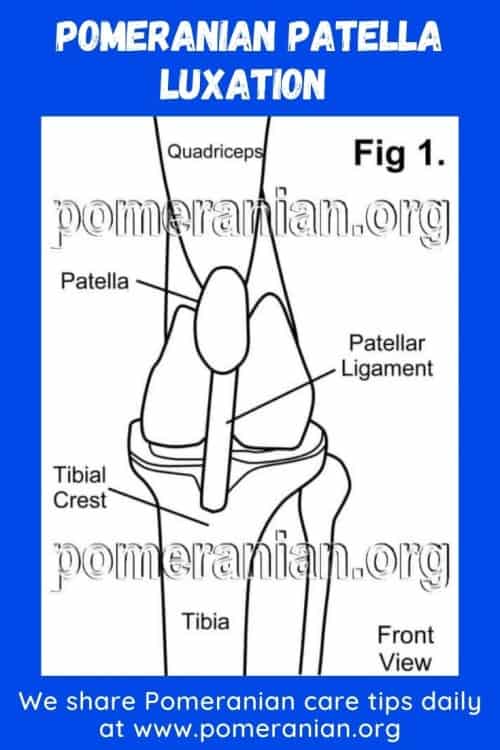
Pomeranian Luxating Patella Surgery Cost
The cost of luxating patella surgery for dogs varies from Vet Clinic to Clinic. Prices can vary from $1500 to $8000 per leg, so shop around for options. It is always a good option to obtain a second opinion prior to opting for a patella operation.
If your Pomeranian’s Patella Grade is a 3 or 4, there are Two Operations to Choose From
One is to make the trochlear wedge deeper. If your pet’s joints are flat, the surgeon will make a deeper V-shaped incision to hold his kneecap in that grove.
The other option is to tighten the joint capsule to ease tension on the ligament or patella capsule.
I recommend analyzing ALL other possible non-surgical options that can add stability to your Pom’s knee BEFORE even considering correction of the problem through surgery.
If surgery is the best choice, be aware that there are always potential risks during surgery, especially from infections and anesthetics. However, the list of risks grows longer because the procedure is carried out on one of your pet’s moving parts that’s also a weight-bearing part.
Pomeranian Luxating Patella Surgery Success Rate
Dog patellar luxation surgery success rate varies a lot. Dog luxating patella surgery success depends on the age and fitness of the patient, degree of luxation, the skill of the surgeon, aftercare, and more.
The List of Risks for your Pomeranian Include:
Pin Problems After Dog Patellar Luxation Surgery
If a pin is inserted into your Pom to assist with the task of holding the joint in position. The pin may move and that means more surgery to take it out. At the pin’s site, an abscess (also called a seroma) may be created and either surgery or drainage is needed.
Patellar Luxation Repair May Collapse
After your Pomeranian has undergone surgery, he’s not allowed to jump or run for approx. two months because that’s the length of time needed to fully stabilize your pet’s health once more. It’s nearly impossible to prevent your dog from being physically active so the repair may easily break down during that “restful” period.
Failed Dog Luxating Patella Surgery Procedure
10% of canines don’t demonstrate any significant improvements after undergoing dog luxating patella surgery. They still feel pain and it’s possible for this problem to cause more issues with other joints and bones.
Pomeranian Hip Dysplasia
Can Pomeranians suffer from Hip Dysplasia? Yes, they can, but Pomeranian hip dysplasia is rare. Hip Dysplasia is a problem usually associated with larger dog breeds.
I have been actively breeding Champion Pomeranians since 1975 and have never seen Pomeranian hip dysplasia.
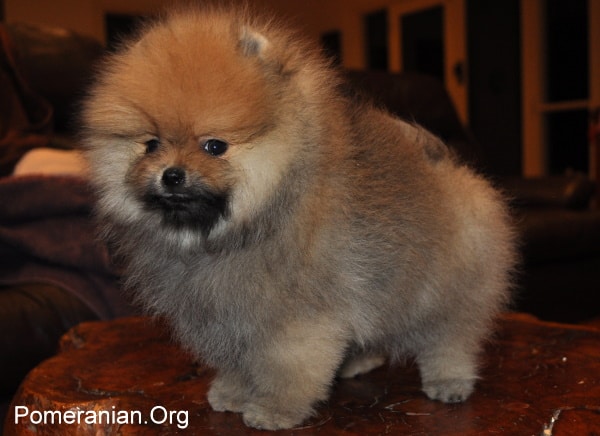
Pomeranian Puppy Limping (Juvenile Pomeranian Patellar Luxation)
Why is your Pomeranian puppy limping? Young animals and children can experience growth spurts that may cause lameness and temporary unsoundness.
When it comes to Pomeranians, the general age for them to experience this is between 5-18 months. 6-month-old puppy limping won’t happen to all Poms, but it’s far from being a strange occurrence.
The time period in which this spontaneous puppy lameness may appear often coincides with teething and is usually an indication of the puppy being fed an incorrect diet for many months. If the puppy is lacking calcium, please don’t start giving calcium supplements. Instead, look at immediately improving your Pomeranian’s diet by increasing his intake of dairy foods such as puppy milk, cheese, and yogurt.
For correct bone development, Pomeranian puppies should be fed quality wet PUPPY food and PUPPY kibble until 12 months of age.
As a breeder, I know lots of dog owners ask their vet for advice, but it’s often the case that vets don’t always provide sound advice. This is why I’m now going to talk about patella luxation. Like the scapula, the patella has some freedom of movement, with a degree of mobility. The reason why young dogs have so much movement within their bones is that they’re soft.
Many people believe the growth plates shut when the dog turns 12 months old, but the reality is that it may not happen until they’re 18 months old. Juvenile patella luxation often appears spontaneously. One day your puppy suddenly starts limping.
Treating Juvenile Pomeranian Patella Luxation
Prior to remedially treating juvenile Pomeranian patella luxation, I’ll cover what a vet should do. To diagnose this problem, he will do an orthopedic examination. However, in some cases, he’ll also have x-rays done.
Patella luxation can be environmental, caused by an earlier injury or your Pom may have a genetic predisposition to developing luxating patellas. Before your vet even mentions a surgical option, he should definitely have x-rays carried out and also discuss with you other options to either prevent or fix this problem. He should tell you that it’s possible your dog may grow out of it on his own. Please do not rush into having dog patellar luxation surgery on a Pomeranian under 12 months of age.
If your pet suffers from unsoundness that’s only intermittent, you have various options to try. The first step is to use cold therapy such as baths and/or ice packs to decrease the aggravation and inflammation in the affected area. Avoid him becoming overweight because that will put additional strain on his joints.
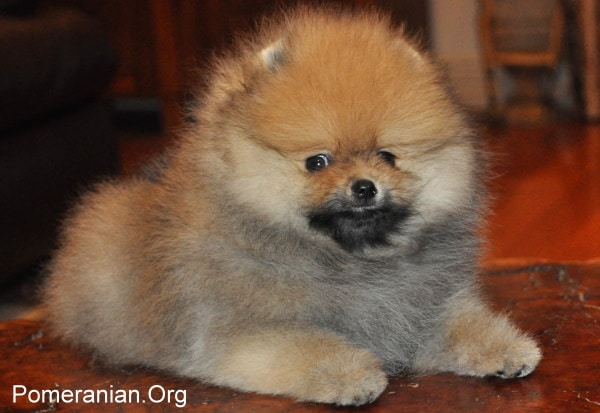
Pomeranian Puppy Diet Requirements
Immediately check your Pomeranian’s diet. Is he being fed an appropriate diet for his age? Increase the amount of dairy food in the diet. Feed him fish (such as sardines) to guarantee he’s receiving enough of the good fats and omegas as they help with the health of his joints. Ask your vet to recommend a good joint health supplement as well.
Puppy Exercise Requirements
Use common sense with the amount of exercise. Confine your Pomeranian puppy to a playpen if he’s limping. Stop him jumping up and down on his hind legs or on couches, etc., and restrict his access to stairs.
Swimming is a great exercise because it’s low impact and can increase the strength in your dog’s ligaments, tendons, and muscles. These all provide joint support without creating pain or straining them. This is an ideal type of cold therapy so it’s perfect if he’s in a period of unsoundness. Finally…be objective!
We know how much love you have for your dog but never let this stop you from seeking a second opinion and always explore all possible choices before seriously considering surgical intervention. I sincerely hope this information has given you a degree of insight and advice into this complicated health condition.
Final Thoughts on Why is My Pomeranian is Limping?
It is essential to know and feed the correct dietary requirements for a dog that is under 12 months old. Do not do surgery on Pomeranians under 18 months of age.
Don’t rush into operations on Pomeranians under 18 months of age. Instead, make sure you stick to the correct dietary requirements for dogs and do nothing about surgery or a specialist until your puppy is at least 18-months old.
Pomeranians are a breed of dog that has been known to suffer from patellar luxation. In this blog post, we’ve talked about the symptoms and causes as well as how this issue may be treated.
Copyright. All Rights Reserved. Pomeranian org.
Please note: while I do discuss health, care, and behavioral issues, you should never use this information as a replacement for advice from qualified veterinarians, diagnoses, or recommended treatment regimes. If you have any worries about the health of your Pomeranian, your first contact should be your regular vet or, if you don’t yet have one, a vet that works locally. Never ignore or avoid treatment and/or advice from your vet because of a piece of information you have read on any website.
N.B. This article regarding Pomeranian health issues was written in consultation with our resident veterinarian.
Dr. Muqeet Mushtaq
DVM, University of Animal and Veterinary Sciences, 2019
MSc. (Hons.) (Animal Breeding & Genetics), University of Agriculture Faisalabad, 2021
References and Further Reading:
[1] Denise Leo “The Pomeranian Handbook”.








